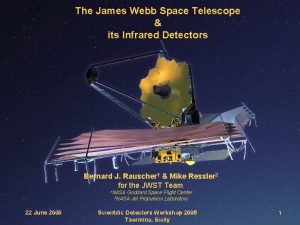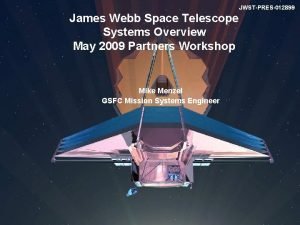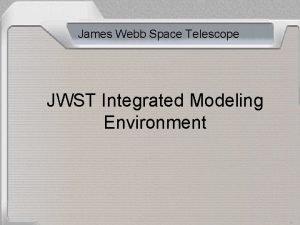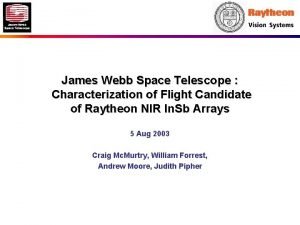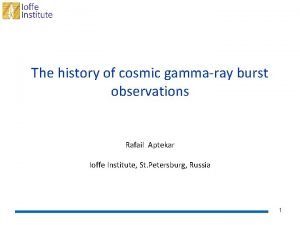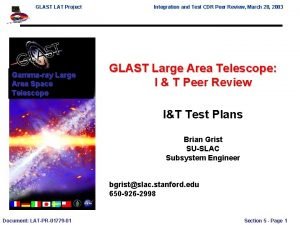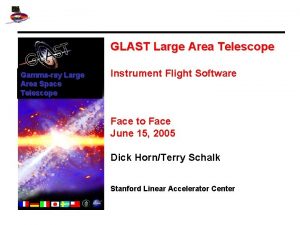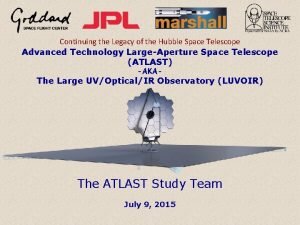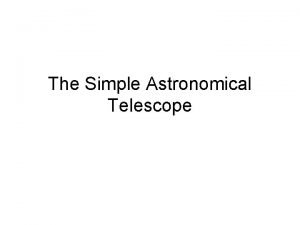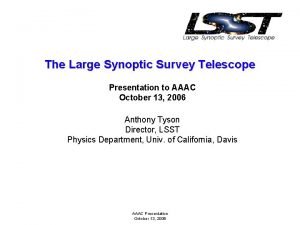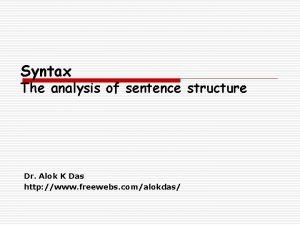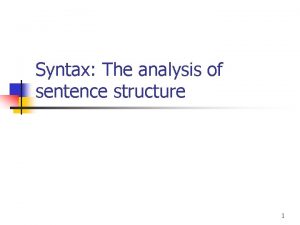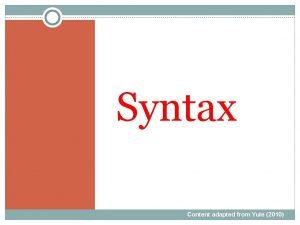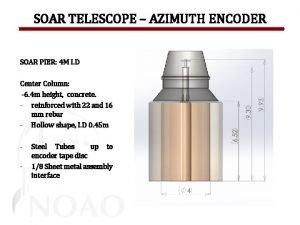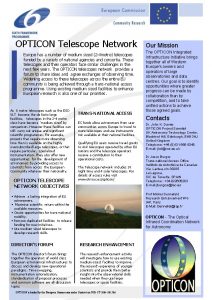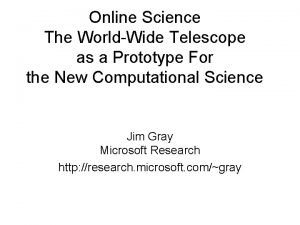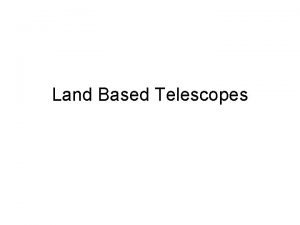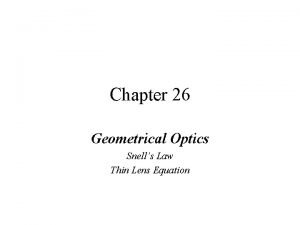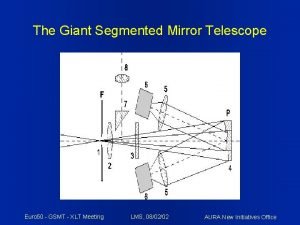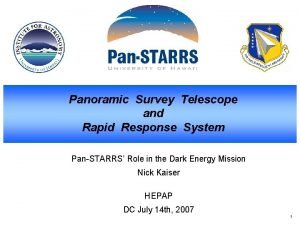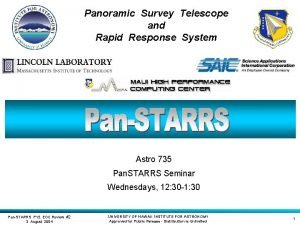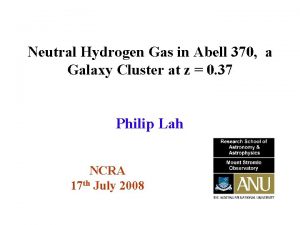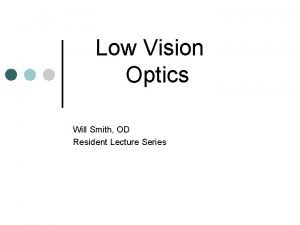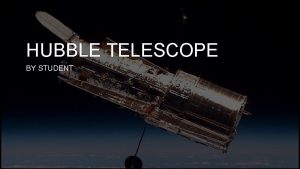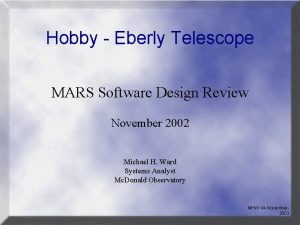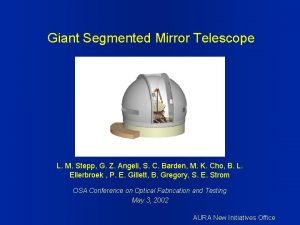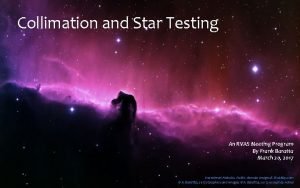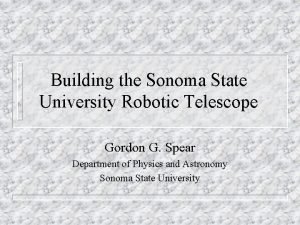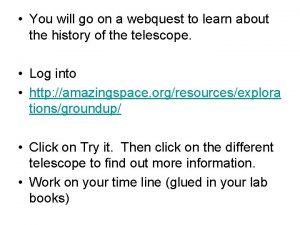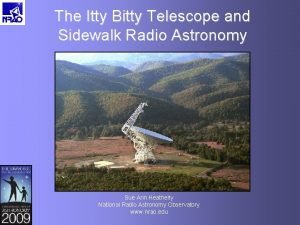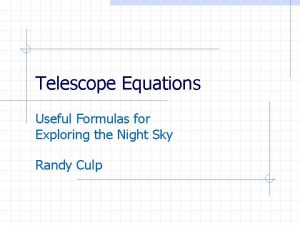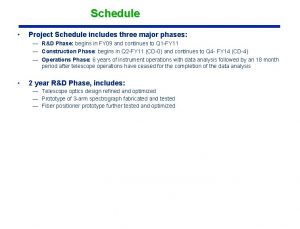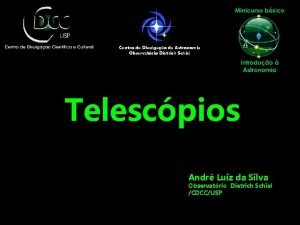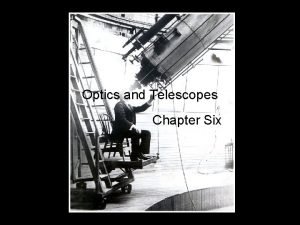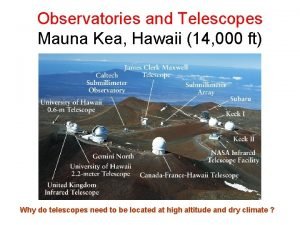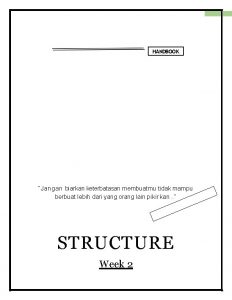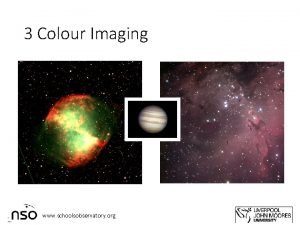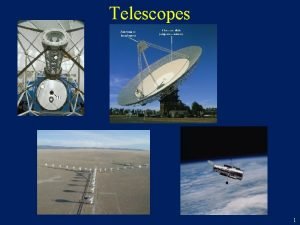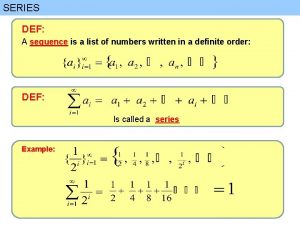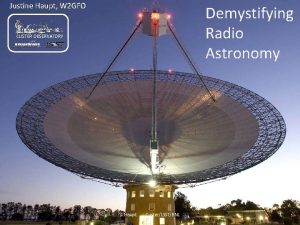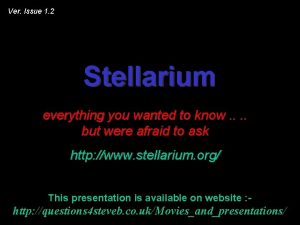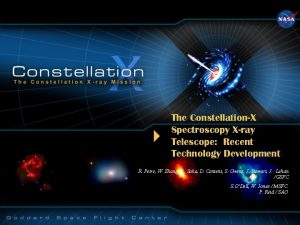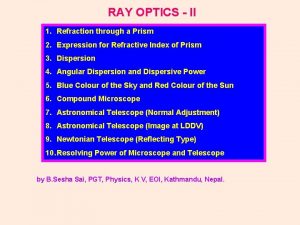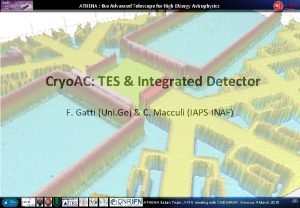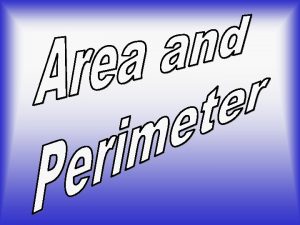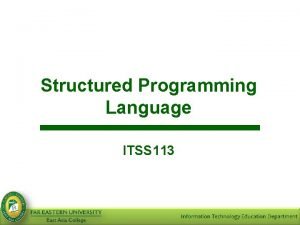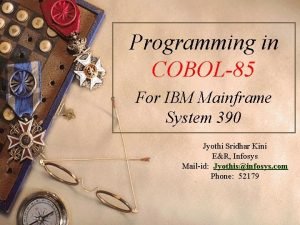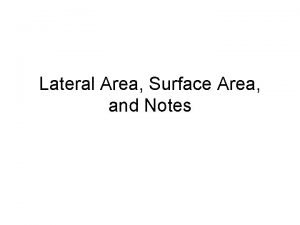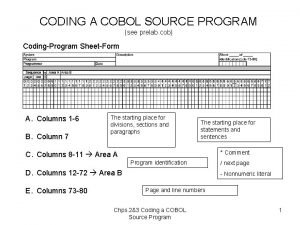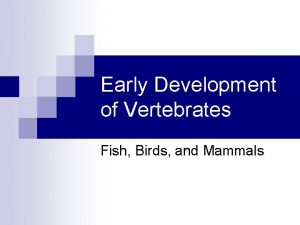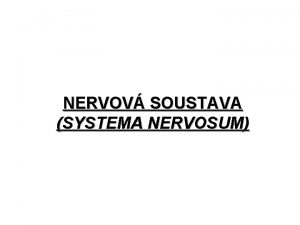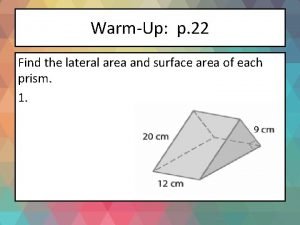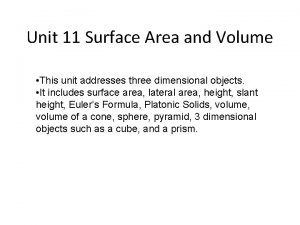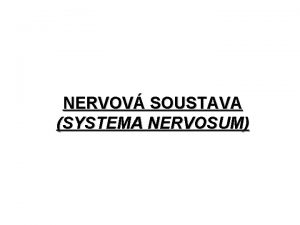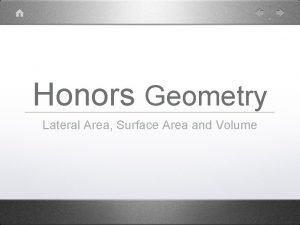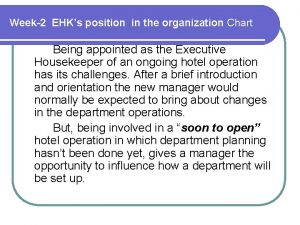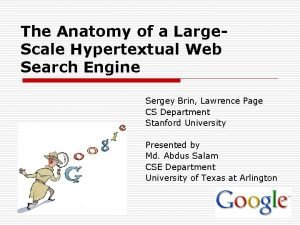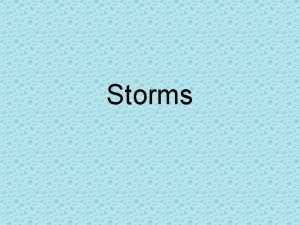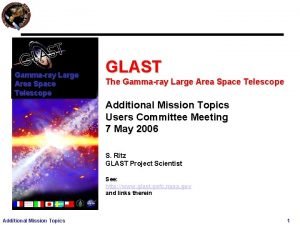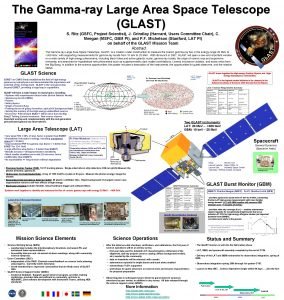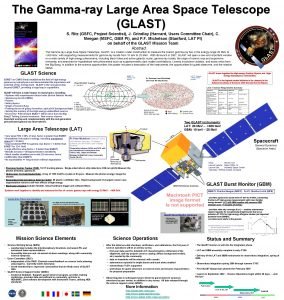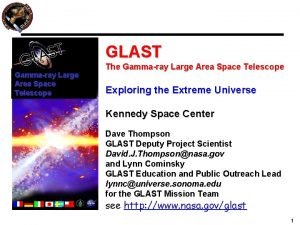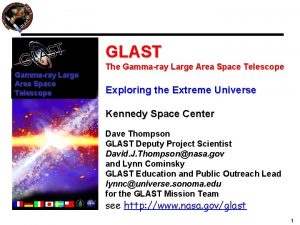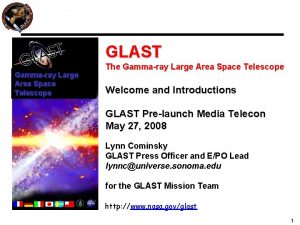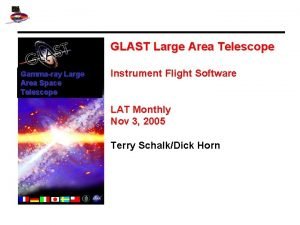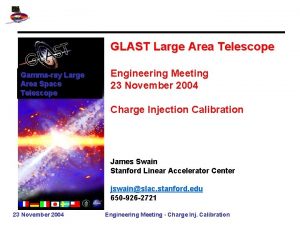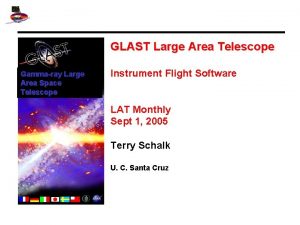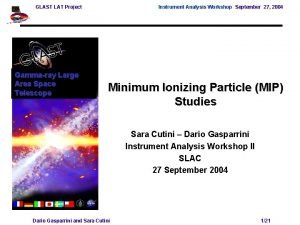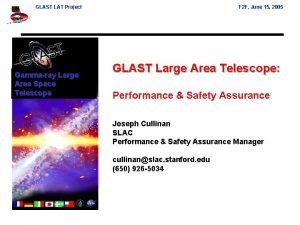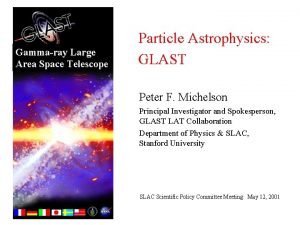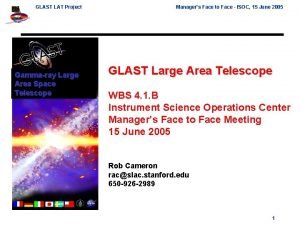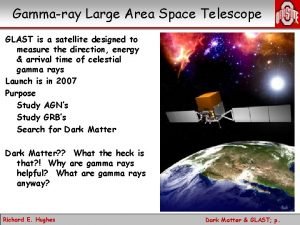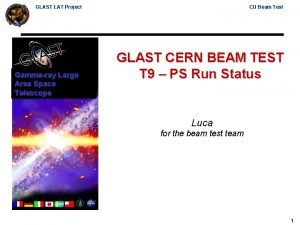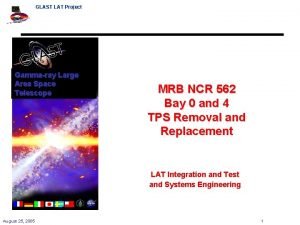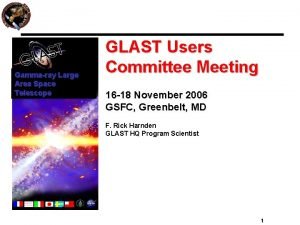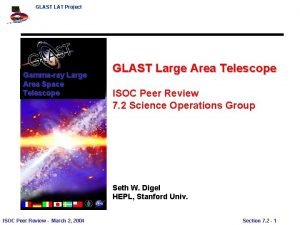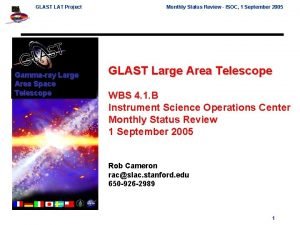GLAST Large Area Telescope Gammaray Large Area Space





































































































- Slides: 101

GLAST Large Area Telescope Gamma-ray Large Area Space Telescope Instrument to Spacecraft Interface Simulator (ISIS) Training March 2005 Jana Thayer Stanford Linear Accelerator Center jana@slac. stanford. edu (650) 926 -4956 http: //wwwglast. slac. stanford. edu/Elec_DAQ/ELX_test/ content/isis_documentation. htm March 30, 2005 ISIS Training

ISIS Training - Agenda • Overview • References • Bringing Up the ISIS • Command Examples • More On Commands • Troubleshooting • Outstanding Issues • Summary March 30, 2005 ISIS Training 2

Objectives • You will be able to— – Power up the ISIS – Select appropriate commands and parameters – Send commands – Analyze output – Correct minor errors – Find more information March 30, 2005 ISIS Training 3

ISIS Training - Overview • Overview – Purpose – Functionality – Requirements – Hardware – Flight Software (FSW) • References • Bringing Up the ISIS • Command Examples • More On Commands • Troubleshooting • Outstanding Issues • Summary March 30, 2005 ISIS Training 4

Purpose • The purpose of the ISIS is to— – Assist the development of electrical interfaces and LAT (Large Area Telescope) – Spacecraft (SC) interaction – Provide a high-fidelity simulator of the primary-side LAT instrument – Present a flight-like hardware and FSW interface for testing and integration of the spacecraft March 30, 2005 ISIS Training 5

Functionality • The ISIS provides the following functionality: – LAT simulator • Power management on the ISIS • Power draw • Ability to monitor temperatures and voltages – ISIS/Spacecraft interface • Reset • Discretes • Science data – ISIS/Spacecraft communication • Exchange of telecommands and telemetry across 1553 March 30, 2005 ISIS Training 6

ISIS and the LAT March 30, 2005 ISIS Training 7

Requirements Tested • 1553 Bus Communication/LAT Telemetry – Alert Telemetry – Spacecraft Commands – Routing of Commands – No-op Commands/Counting of No-op Commands – Ancillary Commands/Counting Ancillary Commands – Attitude Commands/Counting of Attitude Commands – Time Tone Commands/Counting of Time Tone Commands – Automatic Repoint Requests – GBM (Gamma-ray Burst Monitor) Signals • Discrete Control – Output Discrete Lines – Input Discrete Lines – Reset Signal March 30, 2005 ISIS Training 8

Requirements Tested (continued) • Science Data Interface – Hardware Interface – Science Data Patterns – Science Data Rate – Science Packet Length – Transmission Duration • CPU Boot Process • Power – Power Control/Power Draw – Analog Temperatures/Voltages March 30, 2005 ISIS Training 9

Hardware Connections to SC Simulator: 1553, SSR, and Discretes Ethernet and Serial Connections Heater Loads Heater Controls Power feeds : SIU (Spacecraft Interface Unit) PDU (Power Distribution Unit) Environmental Simulator March 30, 2005 PDU Load Box ISIS Training 10

Front Panel: Temp Alarms • • • LAT-DS-05244: Refers to ISIS Enclosure Assembly Drawing Speaker TEMP ALARM TEMP OKAY – TEMP OKAY (Green light) = Good. Normal operation. – TEMP ALARM (Red light) = Warning. Overheating. – TEMP ALARM (Red light) + alarm = Shut down ISIS now! ISIS LOAD TEMP MONITOR March 30, 2005 ISIS Training 11

Front Panel: 1553, Discretes, LGIO • • • JL-232, JL-233: 1553 interface JL-121: SIU/Spacecraft Discretes JL-125, JL-145, JL-124, JL-138: LGIO (Science Data Interface) ETH: Ethernet connection SER: Serial port connection JL-69: External crate connector (for SLAC debugging only) March 30, 2005 ISIS Training 12

Front Panel: Heater Control (+X) • • Heater Load Indicators: Lit = heaters on JL-127, JL-129: Heater Control March 30, 2005 ISIS Training 13

Front Panel: Heater Control (-X) • • Heater Load Indicators: Lit = heaters on JL-140, JL-142: Heater Control March 30, 2005 ISIS Training 14

Front Panel: Power Feed • JL-1, JL-2: Main Power Feed (primary and redundant) • JL-119: SIU Power Feed March 30, 2005 ISIS Training 15

Front Panel: Environmental Simulator JL-123, JL-239, JL-144, JL-131, JL-152, JL-238: Environmental Simulator March 30, 2005 ISIS Training 16

Front Panel: PDU Load Box • Backside of PDU Load Box: Do not touch! – Switch settings will override commanded power settings – For SLAC debugging only March 30, 2005 ISIS Training 17

Hardware: Fan Power Input Must be plugged in to 120 V outlet during operation! March 30, 2005 ISIS Training 18

Hardware Configuration March 30, 2005 ISIS Training 19

FSW Libraries Installed on ISIS March 30, 2005 ISIS Training 20

FSW Libraries Installed on ISIS (continued) March 30, 2005 ISIS Training 21

Test Scripts More information: • LAT ISIS Acceptance Test Plan (LAT-MD-04086) Appendix B March 30, 2005 ISIS Training 22

Test Support Files March 30, 2005 ISIS Training 23

Preliminary Command Telemetry Files • • • • • FILE_cmd_itos. dbx ISIS_tlm_itos. dbx ITC_cmd_itos. dbx ITC_tlm_itos. dbx ITOS_Translation. txt LFS_cmd_itos. dbx LFS_tlm_itos. dbx LHK_cmd_itos. dbx LHK_tlm_itos. dbx MEM_cmd_itos. dbx MEM_tlm_itos. dbx PBC_cmd_itos. dbx PBC_tlm_itos. dbx itos-dbx-param. dbx itos-dbx-tc. dbx itos-dbx-tlm. dbx March 30, 2005 ISIS Training 24

Miscellaneous Include Files (Astro. RT Specific) • • Astro. RT_Sub. Scripts. pl Decode_View_Command_Messages. vi Decode_View_Raw_Packets. pl Decode_View_Raw_Packets. vi Utilities. pl SIIS_LVDS_DISCRETES_CONTROL. vi LVDS_DAQ_Main. pl March 30, 2005 ISIS Training 25

ISIS Training - References • Overview • References – ISIS Documents – LAT ICDs – Other Sources • Bringing Up the ISIS • Command Examples • More On Commands • Troubleshooting • Outstanding Issues • Summary March 30, 2005 ISIS Training 26

References: ISIS Documents • Specifications/Plans – LAT-SS-03975 LAT ISIS Requirements Specification – LAT-MD-04086 LAT ISIS Acceptance Test Plan • Procedures – LAT-TD-03541 ISIS Safe Connection Procedure v LAT-TD-05398 LAT ISIS Acceptance Test Procedure v = Documents most useful for learning how the ISIS works and how to operate it. March 30, 2005 ISIS Training 27

References: ISIS Documents (continued) • • Other v LAT-TD-05426 ISIS FSW Build Description – LAT-TD-02659 FSW Telecommand Telemetry Formats – LAT-DS-03400 PDU Test Box Assembly Drawings – LAT-DS-04439 ISIS DAQ Hardware Mounting Plate – LAT-DS-04440 ISIS GASU Mounting Rail – LAT-DS-04441 ISIS PDU Mounting Rail – LAT-DS-04461 ISIS +X Connector Panel – LAT-DS-04489 ISIS -X Connector Panel – LAT-DS-04593 ISIS Temperature Sensor Enclosure – LAT-DS-04594 ISIS PDU Test Box Front Panel – LAT-DS-04610 ISIS Heater Control Box and VHCP Load Box Mounting and Front Panels – LAT-DS-05147 ISIS SIU Adapter Plate EGSE – LAT-DS-05235 ISIS Enclosure Blank Panel EGSE – LAT-DS-05244 ISIS Enclosure Assembly EGSE – LAT-DS-05245 ISIS Enclosure Panel Temp Monitor EGSE – LAT-DS-05297 ISIS Grounding Diagram – LAT-DS-05444 ISIS 264 Temperature Sensor CCA March 30, 2005 ISIS Training 28

References: LAT ICDs • • • LAT-TD-00639 ACD Electronics Module (AEM) LAT-TD-01547 The Command/Response Unit (CRU) LAT-TD-01546 The Event Builder Module (EBM) LAT-TD-03664 GASU Based Teststands LAT-TD-01545 The GLT Electronics Module (GEM) LAT-TD-00606 LAT Inter-module Communications LAT-TD-00860 The LAT Communications Board (LCB) LAT-TD-01543 The Power Distribution Unit (PDU) LAT-TD-00605 The Tower Electronics Module (TEM) March 30, 2005 ISIS Training 29

Resources: Other Sources • FSW Traveler (package-specific) Documents: – www. slac. stanford. edu/exp/glast/flight/web/FSW_traveler. shtml • FSW in Doxygen – www. slac. stanford. edu/exp/glast/flight/doxygen/Doxyidx. htm • LATDocs – https: //oraweb. slac. stanford. edu: 8080/pls/slacquery/DOCUMENTS. STARTUP? PROJECT=GLAST March 30, 2005 ISIS Training 30

Acronyms • • • • • • ACD: Anti-Coincidence Detector AEM: ACD Electronics Module CRU: Command/Response Unit EBM: Event Builder Module EPU: Event Processing Unit FSW: Flight Software GASU: Global Trigger/AEM/Signal Distribution Unit GBM: Gamma-ray Burst Monitor GEM: Global Trigger Electronics Module GLAST: Gamma-ray Large Area Space Telescope ISIS: Instrument to Spacecraft Interface Simulator LAT: Large Area Telescope LCB: LAT Communications Board PDU: Power Distribution Unit SC: Spacecraft SDIS: Spacecraft Data Interface Simulator SIB: Spacecraft Interface Board SIIS: Spacecraft to Instrument Interface Simulator SIU: Spacecraft Interface Unit TEM: Tower Electronics Module TPS: Tower Power Supply March 30, 2005 ISIS Training 31

ISIS Training - Bringing Up the ISIS • • Overview References • Bringing Up the ISIS – Initial Setup—FSW – Initial Setup—Hardware – Power on the ISIS • Command Examples • More On Commands • Troubleshooting • Outstanding Issues • Summary March 30, 2005 ISIS Training 32

Initial Setup—FSW 1. Prepare the Astro. RT PC 2. Download the Files from the ISIS_ATP CD a) Create this directory for test scripts and results: c: Astro. RTscriptshansene b) Copy the files as shown in the table below: March 30, 2005 ISIS Training 33

Initial Setup—FSW (continued) 3. Regenerate the Telemetry Database 4. Regenerate the Command Database March 30, 2005 ISIS Training 34

Initial Setup—Hardware 1. Before plugging in any power cables, ensure that the SIU and DAQ Main Feed power supplies are set to 28 V. Ø The SIU and PDU voltage must be 28 ± 1 V at all times. Ø There is no undervoltage protection on this hardware. Ø If the voltage drops below 27 V for more than 10 seconds, transistors may overheat and burn out. 2. Connect JL-124 (SC science data) and JL-121 (SC Discretes) on the ISIS to your Science Interface/Discretes connector. 3. Connect your 1553 lines to JL-232 and JL-233 on the ISIS. 4. Connect your Power Supply to JL-1 (DAQ Main Feed - primary) and JL-119 (SIU power) on the ISIS. 5. Power on the SDIS and verify the 1553 interface is enabled. March 30, 2005 ISIS Training 35

Power on the ISIS 1. 2. 3. 4. Primary Boot Secondary Boot Turn on the Main Feed Initialize LAT Housekeeping March 30, 2005 ISIS Training 36

ISIS Internal Power On Sequence JL-119 SIU (booted) 1. Turn on Power Supply 2. Send LPBCRTOSEXEC 3. Send LISISMAINFEEDON • Main Feed Primary • PDU 0 and PDU 1 • GASU Primary PDU JL-1 GASU primary power JL-2 GASU redundant power GASU (Primary) ISIS Front panel March 30, 2005 ISIS Training 37

Power on the ISIS (Primary Boot) 1. Initiate the primary boot process: a) Turn on the ISIS Power Supply. b) Verify that the voltage is 28 V. 2. Verify that the primary boot is progressing: a) In the Astro. RT GLAST Main Menu window, from the menu, select Subsystem, then Subsystem Displays, and then FSW. b) In the Subsystem Menu window, double-click BCI 1553. c) In the BCI_1553 window, observe the Telemetry Housekeeping in the LAT column. When the number begins to increment, the boot is finished. • The primary boot takes approximately 3 minutes. March 30, 2005 ISIS Training 38

Power on the ISIS (Secondary Boot) 1. Send the LPBCRTOSEXEC command with these parameters: 2. Verify that the secondary boot is progressing: • In the BCI_1553 window, observe the Telemetry Housekeeping in the LAT column. • The number does not increment during the boot. • When the number begins to increment, the boot is finished. • The secondary boot takes approximately 45 seconds. March 30, 2005 ISIS Training 39

Turn on the Main Feed 1. Send the LISISMAINFEEDON command with these parameters: 2. Verify that the command is sent by observing the current on the ISIS Power Supply. Current increases from 0. 5 -0. 6 Amps to 1. 0 Amps. March 30, 2005 ISIS Training 40

Turn the ISIS Off and On • To turn the ISIS off 1. Turn off the TEMs, ACD, and EPUs using LISISPOWEROFF. 2. Power off the Power Supply connected to the ISIS. • To turn the ISIS on (after initial setup) 1. Before turning on the power, ensure that the power supply connected to the ISIS SIU and PDU is set to 28 V. Ø The SIU and PDU voltage must be 28 ± 1 V at all times. Ø There is no undervoltage protection on this hardware. Ø If the voltage drops below 27 V for more than 10 seconds, transistors may overheat and burn out. 2. Power on the SDIS and verify the 1553 interface is enabled. 3. Continue with the steps to Power on the ISIS. March 30, 2005 ISIS Training 41

Initialize LAT Housekeeping • Send the LHKSYSRESET command with these parameters: • Initializing LAT Housekeeping will ensure that HSK telemetry will contain measured values for TEM, ACD, and EPU voltages and switch settings. March 30, 2005 ISIS Training 42

ISIS Training - Command Examples • • Overview References • Bringing Up the ISIS • Command Examples – Request Alert Telemetry – Science Data Generation – Auto Repoint Requests (ARR) – Power Management • More On Commands • Troubleshooting • Outstanding Issues • Summary March 30, 2005 ISIS Training 43

Request Alert Telemetry (LISISRQALRTGEN) • Generates ISIS alert telemetry: 1. The spacecraft sends the Request Alert Telemetry command to the LAT. 2. The command requests the LAT to send an alert telemetry packet to the spacecraft. 3. The LAT sends the alert telemetry packet. 4. The alert telemetry packet echoes the data contained in the request. • Use it to: – Request Alert Telemetry from the ISIS on APID 842 • ISIS test script that exercises this telecommand: – ISIS_alert. pl March 30, 2005 ISIS Training 44

Request Alert Telemetry Parameters March 30, 2005 ISIS Training 45

Request Alert Telemetry Procedure 1. Set up feedback windows: a) In a Telemetry Table Template, select this mnemonic for display: LALERTDATA • The value sent to the spacecraft/ground in the alert telemetry packet • After the command is sent, this value should correspond to the value sent in the request for an alert telemetry packet b) In the Raw Packet Count window— • Enter APID 842 • Clear all other APIDs that appear in the window 2. Send the LISISRQALERTGEN command with this parameter (example): March 30, 2005 ISIS Training 46

Request Alert Telemetry Procedure (continued) 3. Observe the feedback windows: a) In the Telemetry Table Template, the telemetry value should echo the value sent in the command: b) In the Raw Packet Count window, the telemetry packet should arrive with APID 842. • APID 842 (0 x 34 A) is within the defined range for alert telemetry for the LAT, per the LAT-SC ICD March 30, 2005 ISIS Training 47

Science Data Generation (LISISSCIDATAGEN) • Initiates simulated science data to be output on the prevailing science data interface • Use it to: – Send science data with these specifications: • Rate • Duration • Packet size • Pattern – – – • Increment Constant Random Walking 1's Transition to all 1’s Transition to all 0’s ISIS test script that exercises this command: – ISIS_Sci. Data. Patterns. pl March 30, 2005 ISIS Training 48

Science Data Generation Parameters March 30, 2005 ISIS Training 49

Sci Data Generation Parameters (continued) Pattern Types (LISISPATTYPE) March 30, 2005 ISIS Training 50

Science Data Generation Procedure 1. Set up LVDS DAQ Main window a) Initialize the LVDS DAQ Main window. b) Ensure LVDS DAQ is connected over TCP/IP to the device containing the LVDS receiver. c) On the LVDS DAQ Main interface, ensure that the “Save to file” option is selected. d) Verify the existence of the path displayed. 2. Send the following sequence of commands (no parameters necessary) a) SDILVDSRESET b) SDILVDSFLUSH c) SDILVDSENABLE March 30, 2005 ISIS Training 51

Sci Data Generation Procedure (continued) 3. Send the LISISSCIDATAGEN command with these parameters (example): – In this example, the ISIS generates Science Data packets with a constant pattern of 0 x. BEEF for 180 seconds, with 512 byte payloads. • The packet size and data rate are mutable, depending on the maximum bandwidth restrictions. So the packet size is adjusted downward to achieve the desired data rate. March 30, 2005 ISIS Training 52

Other Science Data Commands • Science Data Cease Transmission (LISISSTOPSCI) – Sent on the 1553 interface to the LAT – Terminates transmission of simulated science data • Science Data Interface Select (LISISSELSCIIF) – Select primary or secondary interface for output of simulated science data – Parameter March 30, 2005 ISIS Training 53

Get Science Data Generation Status (LISISCLRSCISTATS) • Telecommand – Sent from the spacecraft side to the LAT – Requests diagnostic telemetry containing status counts maintained by the simulated science data generation function • ISIS – Accepts the message – Sends a diagnostic telemetry packet containing the status counts March 30, 2005 ISIS Training 54

Clear Science Data Generation Status (LISISCLRSCISTATS) • Telecommand – Sent from the spacecraft side to the LAT – Requests clearing of status counts maintained by the simulated science data generation function • ISIS – Accepts the message – Clears the status counts March 30, 2005 ISIS Training 55

Request ARR Generation (LISISRPTGEN) • Issues a request for an ARR (Autonomous Re-point Request) – Initiates output of an ARR from the ISIS to the spacecraft on the 1553 interface – Contains parameter values that are echoed back to the spacecraft in the ARR • Use it to: – Generate a sample Autonomous Re-point Request from the ISIS to the spacecraft. • ISIS test script that exercises this command: – ISIS_Auto. Repoint. pl March 30, 2005 ISIS Training 56

Request ARR Generation Parameters March 30, 2005 ISIS Training 57

Request ARR Generation Procedure 1. Send the CMDRESPONSE command with these parameters: • Ensures appropriate command response level is set • This modifies the command response level in the Intertask Communications Package (ITC) to always confirm a command executed by the ISIS task. March 30, 2005 ISIS Training 58

Request ARR Gen Procedure (continued) 2. In a Telemetry Table Template, select the following mnemonics for display · H 720 SCNT · LCM_CMDHDRAPID · LCM_CMDHDRFUNC · LCM_EXESTATUS March 30, 2005 ISIS Training 59

Request ARR Gen Procedure (continued) 3. Send the LISISRPTGEN command with these parameters (example): – In this example, …. March 30, 2005 ISIS Training 60

Request ARR Gen Procedure (continued) 3. Observe the feedback a) In the Telemetry Table Template, the telemetry value should echo the value sent in the command: b) In the Raw Packet Count window, examine the contents of the raw packets on APID 45. • Command will also appear in packet with – APID 600 – Function Code 2 – Payload echoes payload data entered in the command. March 30, 2005 ISIS Training 61

Request ARR Gen Procedure (continued) c) As of this writing, the SDIS is unable to correctly process the ARR command. • Errors indicate that SDIS received a command with – APID 600 – Function Code 2 March 30, 2005 ISIS Training 62

Autonomous Re-point Reply • Command: – Provides acceptance status on an ARR received from the LAT – Values from this command are output via telemetry • Output March 30, 2005 ISIS Training 63

PDU-Based Power On (LISISPOWERON) • Provides capability to turn on the simulated power load for: – 16 Towers (TEMs + TKR + CAL) – ACD – 3 EPUs • Simulated power loads are monitored via housekeeping telemetry • Use it to: – Simulate the power draw of the full LAT – Power individual elements of the LAT on • ISIS test script that exercises this command: – ISIS_Power. pl March 30, 2005 ISIS Training 64

PDU-Based Power On Parameters March 30, 2005 ISIS Training 65

PDU-Based Power On Parameters (continued) March 30, 2005 ISIS Training 66

PDU-Based Power On Procedure 1. In a Telemetry Table Template, select the following mnemonics for display: March 30, 2005 ISIS Training 67

PDU-Based Power On Procedure (continued) 2. Send the LISISPOWERON command with these parameters: – This example turns on TEM 0. March 30, 2005 ISIS Training 68

PDU-Based Power On Procedure (continued) 3. Observe the feedback a) In the Telemetry Table Template, the first three values should be: b) If possible, verify that the current draw on the power supply has increased by approximately 1 amp (0. 9 -1. 0). March 30, 2005 ISIS Training 69

PDU-Based Power On Procedure (continued) 4. Send the LISISPOWERON command with these parameters: – This example turns on EPU 0. March 30, 2005 ISIS Training 70

PDU-Based Power On Procedure (continued) 5. Observe the feedback a) In the Telemetry Table Template, the last three values should be: b) If possible, verify that the current draw on the power supply has increased by approximately 0. 7 amp. March 30, 2005 ISIS Training 71

PDU-Based Power Off (LISISPOWEROFF) • Provides capability to turn off the simulated power load for: – 16 TEMs – ACD – 3 EPUs • Simulated power loads are monitored via housekeeping telemetry • Use it to: – Power individual elements of the LAT off • ISIS test script that exercises this command: – ISIS_Power. pl March 30, 2005 ISIS Training 72

PDU-Based Power Off Parameters March 30, 2005 ISIS Training 73

ISIS Training - More On Commands • Spacecraft Load Shed Notification (LISISLDSHED) • Command HP Heater On or Off (LISISHTROFF) • Drive Discrete Lines (LISISDRVDSCRT) • Monitor Discrete Lines (LISISMNDSCRT • No-Op (LISISNOOP) • Reboot (LISISREBOOT) • Main Feed On (LISISMAINFEEDON) • GBM Calculated Information (LISISGBMINFO) • GBM Re-point Recommendation (LISISGBMREPTREC) • GBM Closeout (LISISGBMCLOSEOUT) • Monitor Command Counts (LISISMNCMDCNTS) • Get Hardware Configuration (LISISGETHWCNFIG) • Get Software Configuration (LISISGETSWCNFIG) March 30, 2005 ISIS Training 74

Spacecraft Load Shed Notification (LISISLDSHED) • Notifies LAT operational power to the SIU and DAQ going down – Sent from the spacecraft to the LAT – Sent no less than 15 seconds prior to removing operational power to the SIU and DAQ • ISIS software shows status in telemetry that command was received • No parameters March 30, 2005 ISIS Training 75

Command VCHP Heater On or Off (LISISHTROFF) • • • Provides capability to set VCHP heater switches on or off Heater switches are repeatedly commanded on or off – Every second – As specified by the ISIS software – Until the refresh stop bit is set to one (RS) Bit masks contained in the command payload are written to the SIB heater control register, individually turning on/off the six +Y radiators and the six -Y radiators. March 30, 2005 ISIS Training 76

ISIS Heater Controls JL-119 SIU (booted) JL-127 JL-129 JL-140 JL-142 1. Turn on Power Supply 2. Send LPBCRTOSEXEC SIU turns heaters off and on as needed. Heater Loads (LEDS) Heater Control Box ISIS Front panel March 30, 2005 ISIS Training 77

Command HP Heater On or Off Parameters n = Heater number. In this context, the six heaters are numbered 0 to 5. March 30, 2005 ISIS Training 78

Command HP Heater Parameters (continued) • Off Masks – Value set by selecting the ±Y heater(s) to turn on or off – Correct value for + or –Y heaters is obtained as follows: • Decide which heaters 0 to 5, you want to turn off • Form the value 2 n for each heater, where n is the number of the heater from zero to five that will be turned off • Calculate the sum of the values determined above. • Set the parameter LISISYPOFF or LISISYMOFF to this value and issue the LISISHTROFF command – Example: • To turn off heater load number two on both the +Y and Y sides, enter 22=4 for both off mask parameters • This will leave the remaining five heaters on each box ON. • You can combine any number of heaters in any order by forming the superposition of several individual heaters. For example, to turn heaters 2, 3, 5 off: 22+23+25=44. March 30, 2005 ISIS Training 79

Drive Discrete Lines (LISISDRVDSCRT) • Causes a 1 or 0 to be output on the two PIDs (5 and 6) connected to the spacecraft • Used for – Causing the ISIS to drive its discrete outputs, the discrete signals sent to the spacecraft • ISIS test script that exercises this command: – ISIS_Discrete. Set. pl March 30, 2005 ISIS Training 80

Drive Discrete Lines Parameters March 30, 2005 ISIS Training 81

Monitor Discrete Lines (LISISMNDSCRT) • PIDs contained on the SIB (#23, #24 and #25) read once • Values (1 or 0) output via telemetry • Used for – Issuing a telecommand to the ISIS to read back its discrete input lines • ISIS test script that exercises this command: – ISIS_Discrete. Read. pl March 30, 2005 ISIS Training 82

No-Op (LISISNOOP) • No-op (no operation) command – Sent from the spacecraft side to the LAT – Verifies SC-LAT interface is established • ISIS software shows status in telemetry via command counters from ITC • ISIS test script that exercises this command: – ISIS_noop. pl March 30, 2005 ISIS Training 83

Reboot (LISISREBOOT) • Sent from the spacecraft to the LAT • Performs a soft reboot of the SIU processor • Difference between hard reboot and soft reboot: – Soft reboot does not repeat the memory check or primary boot. The SIU immediately returns to the state in which it awaits the boot command that initiates the secondary boot. – Hard reboot is the equivalent to issuing a power on reset. The rad 750 will perform its memory check and primary boot, where it will await the boot command that initiates the secondary boot. • ISIS test script that exercises this command: – ISIS_Reset. Signal. pl March 30, 2005 ISIS Training 84

Main Feed On (LISISMAINFEEDON) • Sent from the spacecraft to the LAT • Powers on and initializes PDU and GASU • In response, the LAT— – Initializes hardware – Starts housekeeping telemetry • Operating Hint! – Can’t issue ISIS Main Feed On more than once. – Need to power cycle to change the state • Main Feed affects GASU and PDU power (primary and redundant, on or off) • You can’t switch from primary to redundant GASU without cycling the DAQ main power feed. – You can turn TEMs and EPUs on and off through commands March 30, 2005 ISIS Training 85

ISIS Internal Communications JL-232 1553 SIU GASU JL-233 PDU ISIS Front panel March 30, 2005 ISIS Training 86

Main Feed On Parameters March 30, 2005 ISIS Training 87

Main Feed On (LISISMAINFEEDON) • LISISMAINFEEDON allows the user a one-time capability to select which – DAQ Main Feed to draw from (primary or redundant) – PDU is powered (0, 1, or both) – GASU is powered (primary or redundant) – SSR spigot the data will come from (primary or redundant): Primary GASU Redundant GASU Primary SSR JL-124 JL- 138 Redundant SSR JL-125 JL-145 NOTE: Until GASU and PDU are turned on, you will not be able to – Power TEMs and EPUs on or off – Generate Science Data – Read back housekeeping telemetry dealing with values measured on the PDU or GASU. March 30, 2005 ISIS Training 88

GBM Calculated Information (LISISGBMINFO) • Command – Sent from the spacecraft side to the LAT – Specifies information about a burst sequence • ISIS— – Accepts the message – Prints the contents on the serial connection • Use it to: – Verify the ability of the ISIS to receive and count GBMspecific telecommands. – ISIS will keep a count of GBM Calculated Information telecommands received and will return this count when it is requested by the spacecraft • ISIS test script that exercises this command: – ISIS_GBM_Messages. pl March 30, 2005 ISIS Training 89

GBM Calculated Information Parameters March 30, 2005 ISIS Training 90

GBM Re-point Recommendation (LISISGBMREPTREC) • Command – Sent from the spacecraft side to the LAT – Recommends and provide information for a re-point request from the LAT to the spacecraft • ISIS— – Accepts the message – Keeps a count of GBM messages received • Use it to: – Verify the ability of the ISIS to receive and count GBMspecific telecommands. – ISIS will keep a count of GBM Repoint Recommendation telecommands received and will return this count when it is requested by the spacecraft • ISIS test script that exercises this command: – ISIS_GBM_Messages. pl March 30, 2005 ISIS Training 91

GBM Re-point Recommendation Parameters March 30, 2005 ISIS Training 92

GBM Closeout (LISISGBMCLOSEOUT) • Command – Sent from the spacecraft side to the LAT – Closes out processing for a burst • ISIS— – Accepts the message – Keeps a count of GBM messages received • Use it to: – Verify the ability of the ISIS to receive and count GBMspecific telecommands. – ISIS will keep a count of GBM Closeout telecommands received and will return this count when it is requested by the spacecraft • ISIS test script that exercises this command: – ISIS_GBM_Messages. pl March 30, 2005 ISIS Training 93

GBM Closeout Parameters March 30, 2005 ISIS Training 94

Monitor Command Counts (LISISMNCMDCNTS) • Telecommand – Sent from the spacecraft side to the LAT – Requests generation of diagnostic telemetry containing the receive counts for these commands • No-op • Ancillary Message • Attitude Message • Time Tone • ISIS – Accepts the message – Sends back a diagnostic telemetry message containing the prevailing counts March 30, 2005 ISIS Training 95

Get Hardware Configuration (LISISGETHWCNFIG) • Telecommand – Sent from the spacecraft side to the LAT – Requests download via diagnostic telemetry of the prevailing hardware configuration • ISIS – Accepts the message – Sends a diagnostic telemetry packet containing FPGA version numbers for the hardware residing in the ISIS system March 30, 2005 ISIS Training 96

Get Software Configuration (LISISGETSWCNFIG) • Telecommand – Sent from the spacecraft side to the LAT – Requests download via diagnostic telemetry of the prevailing software configuration • ISIS – Accepts the message – Sends a diagnostic telemetry packet containing the file and module ID numbers for the loaded application software March 30, 2005 ISIS Training 97

Get Software Configuration Parameters • Parameters • Device Types March 30, 2005 ISIS Training 98

Operating Hints! • When in doubt, run LAT-TD-05398, ISIS Acceptance Test Procedure, Section 5. 3. 4, Test Setup Procedure • Boot problems: – Verify that SIU is powered • Check that JL-119 is plugged in • Power supply reads 28 V and 0. 5 – 0. 7 A (SIU alone) – Check that PBC flags are set correctly (see LAT-TD-05398) • LPBCSBCFLAGSHI = 0 x 5400 • LPBCSBCFLAGSLO = 0 x. C 000 No communication with ISIS: – Verify that SIU is powered – Is 1553 interface enabled? No science data: – Reboot entire system, reissuing LISISMAINFEEDON with parameters specified in Section 5. 3. 4 of LAT-TD-05398 – Plugged into JL-124? • • March 30, 2005 ISIS Training 99

Summary • When in doubt, run LAT-TD-05398, ISIS Acceptance Test Procedure, Section 5. 3. 4, Test Setup Procedure • The ISIS power supply should always be set to 28 V ± 1 V • If all else fails, call Jana: Jana Thayer (650) 926 -4956 jana@slac. stanford. edu March 30, 2005 ISIS Training 100

Send a Command 1. In the Astro. RT GLAST Main Menu window, from the menu, select Commanding and then Select/Send Command. – The Command Selection window appears. 2. In the Command Selection window, double-click the mnemonic. – If the command has parameters, the Enter Parameter Values window appears. 3. Enter the parameter values in the Data Value column. 4. Click OK. – The Command Selection window appears. 5. Click Send. March 30, 2005 ISIS Training 101
 Glast tm
Glast tm Xanthodermie
Xanthodermie High definition space telescope
High definition space telescope James webb space telescope nasa
James webb space telescope nasa Mri heat
Mri heat James webb space telescope
James webb space telescope Raytheon james webb space telescope
Raytheon james webb space telescope That was due today
That was due today Venera 14 images
Venera 14 images How large is space
How large is space How large is space
How large is space How large is space
How large is space How large is space
How large is space Unscented trajectory chapter 5
Unscented trajectory chapter 5 Space junk the space age began
Space junk the space age began Camera space to world space
Camera space to world space Cartesian space vs joint space
Cartesian space vs joint space World space to screen space
World space to screen space What is angular magnification
What is angular magnification Monolithic telescope
Monolithic telescope Land based telescope
Land based telescope Telescope pointing model
Telescope pointing model Phrase structure rules
Phrase structure rules Lexical ambiguity examples
Lexical ambiguity examples Tree diagram syntax
Tree diagram syntax A refracting telescope produces an image using a(n) ____.
A refracting telescope produces an image using a(n) ____. Azimuth encoder
Azimuth encoder Opticon telescope
Opticon telescope Worldwide telescope online
Worldwide telescope online History of telescopes timeline
History of telescopes timeline Land based telescopes
Land based telescopes Galilean telescope magnification
Galilean telescope magnification Are fan worms decomposers
Are fan worms decomposers Momfos
Momfos Panoramic survey telescope and rapid response system
Panoramic survey telescope and rapid response system Panoramic survey telescope and rapid response system
Panoramic survey telescope and rapid response system Radio telescope
Radio telescope Kirsten places her surveyor's telescope
Kirsten places her surveyor's telescope Will smith telescope
Will smith telescope Hubble telescope history
Hubble telescope history Telescope hobby lobby
Telescope hobby lobby Giant segmented mirror telescope
Giant segmented mirror telescope Star testing telescopes
Star testing telescopes Robotic telescope hire
Robotic telescope hire Telescope history timeline
Telescope history timeline Itty bitty telescope
Itty bitty telescope Telescope equations
Telescope equations Telescope how begins
Telescope how begins A hollow tube that holds the eyepiece lens
A hollow tube that holds the eyepiece lens History of the world in a nutshell
History of the world in a nutshell Magnitude limite telescope
Magnitude limite telescope Telescope simulator
Telescope simulator Telescope how to use
Telescope how to use Chromatic aberration affects reflector telescopes.
Chromatic aberration affects reflector telescopes. Hale telescope at palomar observatory toefl
Hale telescope at palomar observatory toefl Radio telescope
Radio telescope Which telescope detects invisible electromagnetic radiation
Which telescope detects invisible electromagnetic radiation Nasa telescope
Nasa telescope Structure of radio telescope
Structure of radio telescope Radio telescope
Radio telescope Telescoping series
Telescoping series Justine haupt
Justine haupt Naap labs
Naap labs Stellarium telescope control plugin download
Stellarium telescope control plugin download Xray telescope
Xray telescope Esafly
Esafly Telescope and microscope
Telescope and microscope Telescope
Telescope Einstein telescope sardegna
Einstein telescope sardegna Jwst
Jwst Advanced telescope for high energy astrophysics
Advanced telescope for high energy astrophysics An open space surrounded by sloping land
An open space surrounded by sloping land A large geographic area characterized
A large geographic area characterized Wet
Wet Dance is a way of knowing and communicating
Dance is a way of knowing and communicating Area is the amount of space
Area is the amount of space Lateral perimeter
Lateral perimeter What is structured programming language
What is structured programming language Ibm system/390
Ibm system/390 Curved surface area of cone
Curved surface area of cone What is lateral area
What is lateral area Cobol area a and area b
Cobol area a and area b Cleavage in birds
Cleavage in birds Area nervina area radicularis
Area nervina area radicularis Area vs surface area
Area vs surface area Edentulous maxillary landmarks
Edentulous maxillary landmarks Find the lateral area and surface area of each prism
Find the lateral area and surface area of each prism Find the volume of the composite solid
Find the volume of the composite solid Area nervina area radicularis
Area nervina area radicularis Area nervina area radicularis
Area nervina area radicularis La=ph geometry
La=ph geometry Lateral area of hexagonal prism
Lateral area of hexagonal prism Tall grande
Tall grande Housekeeping position chart
Housekeeping position chart Linear geography
Linear geography Degrees of comparison lazy
Degrees of comparison lazy Label the large intestine
Label the large intestine Large intestine function in digestive system
Large intestine function in digestive system The gray-brown haze often found over large cities is called
The gray-brown haze often found over large cities is called The anatomy of a large scale hypertextual web search engine
The anatomy of a large scale hypertextual web search engine The anatomy of a large scale hypertextual web search engine
The anatomy of a large scale hypertextual web search engine Large scale rotating air mass
Large scale rotating air mass



